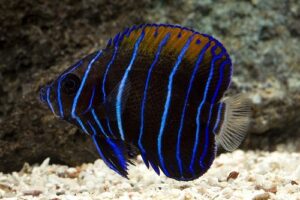The Establishment of the Nitrogen Cycle in Marine Aquaria
Basic to the stability of the natural marine ecosystem are a number of biogeochemical cycles, of which the nitrogen cycle is one. This cycle, evolved and established early in the history of the earth, cycles nitrogen from organism to organism, from inert to animate material, and from inorganic to organic forms.
In contrast, the marine aquarium, an essentially unbalanced , disorganized microcosm at its inception, must re-enact these beginnings each time it is set up. All the elements are present, but they must find a harmony of balance, an equilibrium supporting all. They must go through an ordered set of biochemical reactions to establish the cycle once again. It may be of benefit here to briefly discuss the balanced cycle in its basic form as it applies to the marine aquarium.
The cycle is largely initiated by excreta in the form of ammonia from fish and invertebrates. The oxidation of ammonia to nitrate is accomplished in two steps, both of which require large stores of oxygen. The first step is the conversion of ammonia to nitrite by bacteria of the genus Nitrosomonas; the second step, the conversion of nitrite to nitrate, is brought about by bacteria of the genus Nitrobacter. These oxidations produce the energy necessary to maintain the life processes of the bacteria, nitrite to nitrate merely byproducts of more significant reactions.
Nitrogen in any of these three forms, ammonia, nitrite, and nitrate, may be utilized by plants, although the preferred form is nitrate. Through the process of denitrification the plant incorporates the nitrogen into its structure, and the organic protein thus formed is subject to decay or assimilation by animals. The occurrence of either completes the cycle.
In order to elucidate some of the reactions which occur in establishing this cycle during the early weeks, a marine aquarium was monitored for nitrite and nitrate production for a period of forty five days. The aquarium was of fifty-five gallon, all glass construction, fitted with an under-gravel and an outside carbon filter. The filter bed consisted of approximately three inches of calcite chips of three to five millimeter size. The aquarium was maintained at room temperature and under fluorescent light for sixteen hours a day. Synthetic sea salt was added to tap water until a density of 1.0200 was established. Analysis for nitrate and nitrite basically followed procedures outlined by Strickland and Parsons (1968).
The method of approach was to inoculate the aquarium with algae on the first day and continue monitoring for fourteen days. At that time three Pacific anemones were introduced, and monitoring continued for an additional thirty one days. The filter bed was bare except for one large previously treated piece of coral.
In addition to nitrite and nitrate analysis, temperature, density, and pH data were recorded.
For the first fourteen days prior to invertebrate introduction the nitrite concentration remained stable at 0.1 ppm while the nitrate varied somewhat around an average of 10.4 ppm.
Immediately after invertebrate introduction, the nitrite concentration began to increase, slowly at first, then rapidly to a peak of 11.2 ppm on the twenty eighth day. Within four days the nitrite level then decreased to 0.003 ppm and remained negligible (0.03 ppm) until the end of the period.
In contrast, the nitrate concentration did not begin to increase until the eighteenth day, and a peak of 40.5 ppm was reached on the twenty ninth day, one day after peak nitrite concentration. The concentration then declined to twenty five ppm by the thirty first day and remained largely stable until the end of the period.
The entire nitrite portion of the cycle took eighteen days, while the nitrate portion encompassed thirteen days from onset, through peak, and back to stability. The relative chronological positions of these curves follow closely that which would be expected in the process of denitrification. Nitrite generated first is converted to nitrate, the former increasing prior to the latter.
pH conditions varied considerably over the forty five day period, averaging 7.6 prior to invertebrate introduction, declining to a low of 6.5 at peak nitrite and increasing to an average of 7.8 after the establishment of the cycle. The low of 6.5 was caused by the release of hydrogen ions during the nitrite production, and the immediate pH increase was undoubtedly due to the compensation of the carbonate buffer system.
Algal growth was not visually observed until the sixteenth day, after which it increased to a stable plateau by the end of the period. Tis preliminary data indicates algal growth does not proliferate until sufficient nitrate has been produced.
The nitrogen cycle is a multifaceted system whereby components are generated in a predetermined order until stability has been attained. It must be borne in mind, however, that the components are subject to alterations in concentration and duration, as they are dependent on many variables. The establishment of the cycle cannot be expected to take the same precise pattern each and every time the aquarium is set up. Factors such as bacterial population, chemical inhibitors, type and density of specimens, light duration and wavelength among others will affect the exact pattern followed. The basic chronological order, however, will always be the same described here.
References
Strickland, J. D. H., and T. R. Parsons, A practical handbook of Seawater Analysis, Fisheries Research Board of Canada, Bulletin 167, Ottawa, 1968, pp71-80.